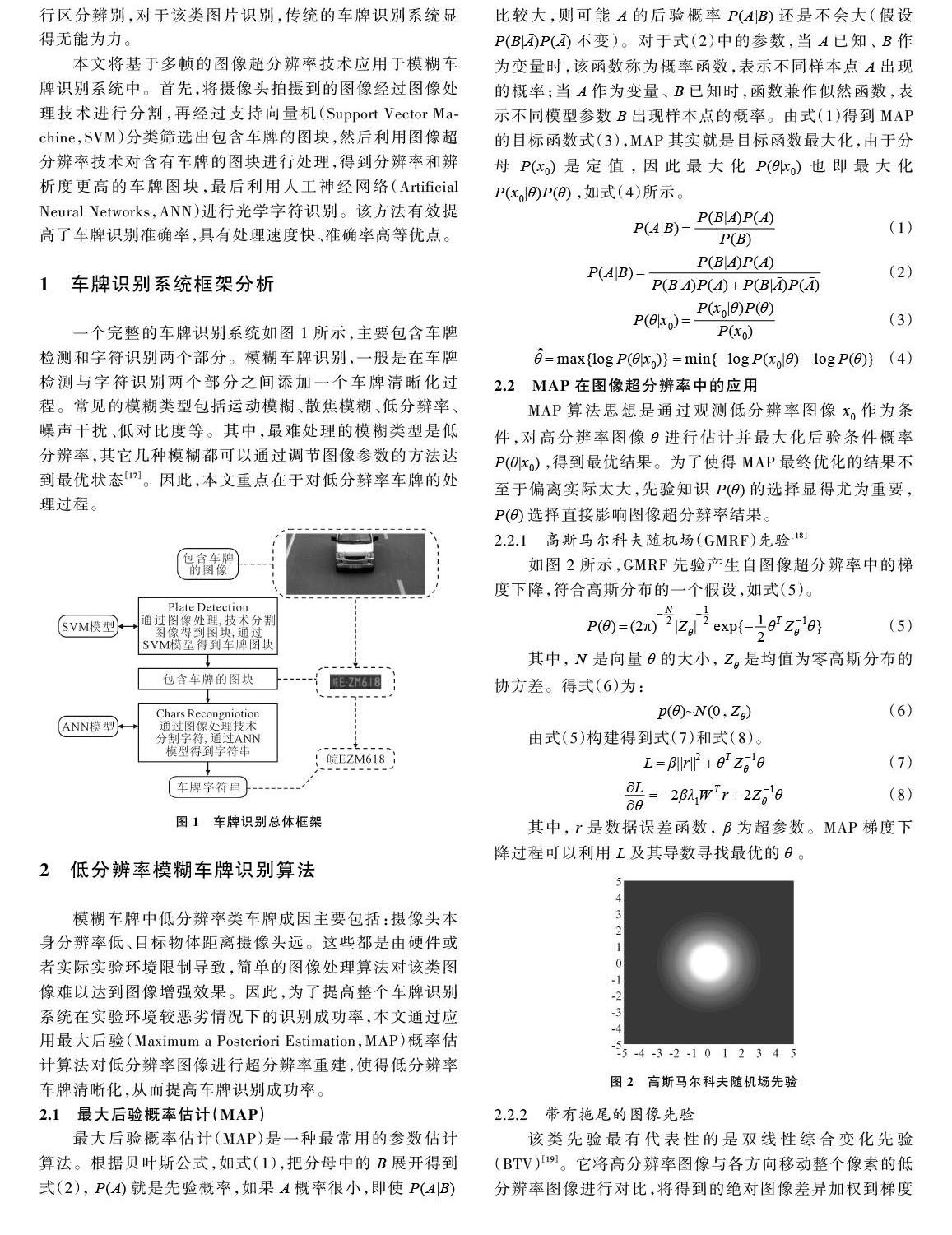图像超分辨率在模糊车牌识别系统中的应用
2019-05-24骆立志吴飞曹琨
骆立志 吴飞 曹琨



摘 要:车牌识别技术种类繁多,理想情况下识别率已达到99%,而对于远距离模糊不清的抓拍图片,识别效果还不够,为此提出一种利用图像超分辨率重建技术提高模糊车牌识别率的方法。首先利用图像处理方法对图片进行分割;其次利用支持向量机(SVM)对分割得到的图块进行分类,筛选出车牌图块;再利用多帧低分辨率车牌图块进行最大后验估计(MAP)超分辨率重建,得到比较清晰、便于识别的车牌;最后利用人工神经网络(ANN)方法进行光学字符识别(OCR),最终得到识别结果。实验表明,与传统车牌识别技术相比,该方法具有更强的鲁棒性,且在模糊车牌识别中正确率明显提高。
关键词:车牌识别;超分辨率;支持向量机;人工神经网络;图像识别
DOI:10. 11907/rjdk. 182142
中图分类号:TP317.4 文献标识码:A 文章编号:1672-7800(2019)005-0177-04
Abstract: Nowadays plate recognition technology is blooming everywhere. Some people even claim that their recognition rate has reached 99%. However, those are some of the ideal cases of recognition rate, for those long-distance blurred snapped pictures, their methods will seem powerless. In this paper, a method of using image super-resolution reconstruction technology to improve the recognition rate of fuzzy license plates is proposed. This method first uses image processing to segment the image, and then uses support vector machine (SVM) to classify and screen out the license plate tiles, and then uses the multi-frame low-resolution plate tiles to perform maximum a posteriori (MAP) estimation super-resolution reconstruction and obtain a relatively clear and easy recognition of the plate, and finally use the artificial neural network (ANN) method for optical character recognition (OCR) to get the plate recognition results. Experiments show that this method is more robust than the traditional license plate recognition technology, and the correct rate is significantly improved.
Key Words: plate recognition; super-resolution; support vector machine; artificial neural network;image recognition
0 引言
作為交通控制系统的重要组成部分,车牌识别系统利用计算机应用技术实现车牌认读,提高了交通控制系统自动化和智能化水平。车牌识别系统在交通事故自动测报、交通管控和交通流量管理等方面发挥着越来越重要的作用,被广泛应用于停车场、居民小区、桥梁和公路收费站、公路流量监测站等认证车牌的实际交通系统中[1]。一般情况下,车牌识别系统主要包含两个过程:车牌检测和字符识别[2]。
车牌检测是指对包含车牌的图像进行分析,最终截取出只包含车牌的一个图块。其方法主要有颜色特征[3]、纹理特征[4]、字符特征[5]、边缘特征[6,7]和灰度跳变特征[8]等。字符识别目的就是从上一个车牌检测步骤中获取得到的车牌图块,进行光学字符识别(Optical Character Recognition,OCR),其方法主要有模板匹配法[9-12]、人工神经网络法[13,14]和特征提取法[15,16]。
一般近距离且光照充足情况下,高清摄像头捕获的图片经过以上两步基本上可进行高精准度车牌识别。然而,远距离或高速公路上抓拍获取的图片在提取车牌图块后像素一般都非常低,甚至无法通过人眼和人类先验知识进行区分辨别,对于该类图片识别,传统的车牌识别系统显得无能为力。
本文将基于多帧的图像超分辨率技术应用于模糊车牌识别系统中。首先,将摄像头拍摄到的图像经过图像处理技术进行分割,再经过支持向量机(Support Vector Machine,SVM)分类筛选出包含车牌的图块,然后利用图像超分辨率技术对含有车牌的图块进行处理,得到分辨率和辨析度更高的车牌图块,最后利用人工神经网络(Artificial Neural Networks,ANN)进行光学字符识别。该方法有效提高了车牌识别准确率,具有处理速度快、准确率高等优点。
1 车牌识别系统框架分析
一个完整的车牌识别系统如图1所示,主要包含车牌检测和字符识别两个部分。模糊车牌识别,一般是在车牌检测与字符识别两个部分之间添加一个车牌清晰化过程。常见的模糊类型包括运动模糊、散焦模糊、低分辨率、噪声干扰、低对比度等。其中,最难处理的模糊类型是低分辨率,其它几种模糊都可以通过调节图像参数的方法达到最优状态[17]。因此,本文重点在于对低分辨率车牌的处理过程。
